Explore Chile’s rich history with our guide to historical treasures. Historical landmarks in Chile tell fascinating stories, from prehistoric petroglyphs engraved into the desert sands to colonial-era architectural wonders. Discover pre-Columbian secrets and vestiges of ancient societies via complex rock engravings. Explore colonial towns, whose cobblestone streets echo stories of conquests and commerce. Each location reveals layers of Chile’s past, making for an enthralling excursion for history aficionados. So, set off on a time-traveling adventure, immersing yourself in the fascinating histories woven within the country’s landscapes and landmarks. Discover the fascination of Chile’s historical treasures that are just waiting to be discovered.
Santiago
For history aficionados, Santiago, Chile’s bustling metropolis, is a historical treasure trove. The city has notable sites that narrate Chile’s history and are steeped in colonial beauty. Explore Santiago’s center, Plaza de Armas, which is flanked by ancient structures such as the Metropolitan Cathedral and the Central Post Office. Also, you can wander around Barrio Paris-Londres, a neighborhood with European-style buildings evocative of 19th-century beauty in Santiago. The Pre-Columbian Art Museum, which displays relics from ancient civilizations, will take you back to the city’s indigenous roots. Visit La Chascona, the former house of Nobel winner Pablo Neruda, which provides insight into the famed poet’s life. To gain a better knowledge of Chile’s political history, visit the Museum of Memory and Human Rights. This museum documents the country’s turbulent past under Pinochet’s dictatorship.

Santiago; Best tourist destinations in Chile for history buffs
Cerro Santa Luca, an iconic hill in the city center, is historically significant. Because it was originally a ritual location for the indigenous Mapuche people. In conclusion, Santiago’s ancient landmarks merge harmoniously with current attractions, offering history buffs an engaging experience that provides a vivid glimpse into Chile’s enthralling past.
Valparaíso
The rich maritime history of Valparaiso, a UNESCO World Heritage Site, entices history aficionados. This beautiful tapestry of Victorian buildings and small meandering lanes is nestled along Chile’s Pacific coast. During the California Gold Rush, the port was an important hub of international trade. Explore the Naval and Maritime Museum, which provides insight into Chile’s naval history during the Pacific War. Moreover, the city’s ancient funiculars, which date back to the late 1800s, provide a unique way to explore its high slopes and take in the scenery. Explore Cerro Alegre and Cerro Concepción, neighborhoods with exquisite colonial architecture and lively street art that convey the story of Valparaso’s bohemian legacy.

Valparaíso; Best tourist destinations in Chile for history buffs
Visit La Sebastiana, the former home of Nobel laureate Pablo Neruda, which displays his varied collections and provides insights into the city’s cultural history. To sum up, Valparaso’s historical significance and artistic flare make it an intriguing location, with a seamless combination of culture and legacy to discover for history aficionados.
Valdivia
Valdivia, a historical city, entices history aficionados with its interesting past. Also, it is known for its Spanish colonial forts and the Valdivian Fort System, which are a testimony to Chile’s colonial past. During the 17th century, the city served as a strategic stronghold, protecting against pirate invasions and indigenous uprisings. Explore the Fort Niebla ruins, along with cannons and ancient relics that provide insight into Chile’s colonial fortifications. Visit the Valdivia Museum of Anthropology and History, which exhibits indigenous Mapuche culture as well as the city’s colonial background. Furthermore, the Calfuco Winery, which dates back to 1907, provides an insight into the region’s winemaking traditions. Stroll around the lovely waterfront, which is filled with ancient structures and craft vendors.

Valdivia; Best tourist destinations in Chile for history buffs
A visit to the Kunstmann Brewery gives you a flavor of the city’s German influence. Kunstmann Brewery dates back to its European immigrants. Valdivia’s historical sites, paired with its gorgeous surroundings, provide history buffs with a fascinating experience, making it an important stop on any historical tour of Chile.
Chiloé Island
Chiloé Island, off Chile’s southern coast, entices history buffs with its distinct cultural legacy. This island is well-known for its UNESCO-listed wooden churches. Those churches are a mix of Jesuit and local Huilliche architectural styles that reflect Chiloé’s colonial history. Explore the 16 ancient churches, including the renowned Church of Castro, each with a unique story to tell. Moreover, the island is rich in folklore, with a long history of myths, stories, and superstitions that have shaped its distinct way of life. Visit the Museo de las Tradiciones Chonchinas in Chonchi. It displays relics from the island’s past and provides insight into the island’s nautical, agricultural, and artisanal background. Explore Chiloé’s maritime tradition at the Museo Nao Victoria, which is dedicated to the island’s nautical history and adventures.

Chiloé Island; Best tourist destinations in Chile for history buffs
Stroll through Castro’s palates (stilt homes), which were once lively trading hubs and now provide a fascinating look into the island’s history. The peculiar historical charm of Chiloé Island, along with its stunning surroundings, makes it a must-see destination for history aficionados. So, it is delivering an immersive voyage into Chilean legacy and culture.
Santa Cruz
Santa Cruz, located in Chile’s famous Colchagua Valley, entices history buffs with its rich cultural legacy. This lovely town is located in Chile’s wine region and offers a delightful combination of vineyards and historical structures. In addition, the Colchagua Museum is a rich mine of artifacts and displays representing Chile’s pre-Columbian and colonial history. The numerous collections of the museum give insights into indigenous civilizations and the Spanish conquest, making it an instructive and fascinating experience. Santa Cruz also holds the Fiesta de la Vendimia (Harvest Festival). It is a lively celebration of wine, culture, and history. Visitors may also stroll through the town’s ancient streets, which are lined with colonial-style houses, and visit the Santa Cruz Plaza, which serves as a focal center surrounded by attractive cafés and stores.

Santa Cruz; Best tourist destinations in Chile for history buffs
The adjacent MontGras Winery provides excursions, allowing visitors to learn about the region’s viticultural heritage. Santa Cruz’s distinct blend of history, wine, and local traditions makes it an ideal location for history fans looking for a cultural and historical excursion in Chile.
La Serena
La Serena, located on Chile’s Pacific coast, is a historical treasure that captivates history buffs. This city, which was built in the 16th century, has colonial elegance. Plaza de Armas, the major plaza, is home to architectural marvels such as the Cathedral of La Serena, a beautiful monument built in 1844. Also, the Archaeological Museum houses relics from the ancient Diaguita and Molle civilizations, providing a peek into the region’s pre-Columbian past. The city’s colonial-style churches, such as Iglesia San Francisco, demonstrate Spanish influence with beautiful woodwork and sacred artifacts.

La Serena; Best tourist destinations in Chile for history buffs
The ancient La Recova Market immerses tourists in local culture by selling traditional crafts and regional items. Furthermore, the surrounding Elqui Valley, noted for pisco manufacturing, has ancient vineyards and distilleries. La Serena is a gateway to the Mamalluca Observatory, which is great for stargazers interested in astronomical history.
La Serena’s distinct combination of colonial architecture, archeological treasures, and astronomy possibilities make it an ideal visit for history fans, offering a compelling voyage through Chilean legacy and the universe.
Petroglyphs of the Atacama Desert
The Atacama Desert Petroglyphs, engraved into the rough terrain of northern Chile, serve as ancient storytellers for history aficionados. These rock carvings, which date back thousands of years, provide a glimpse into pre-Columbian societies such as the Atacameo and Tiwanaku. These complex petroglyphs, scattered over the desert, represent scenes of daily life, astronomical happenings, and also ancient civilizations’ spiritual beliefs.

Petroglyphs of the Atacama Desert; Best tourist destinations in Chile for history buffs
Visitors may visit ancient sites such as Yerbas Buenas, where petroglyphs cover the rocks, telling the stories of indigenous tribes. The Pintados Geoglyphs, which are gigantic figures carved into the desert floor, demonstrate creative talent as well as cultural value. Moreover, the Hierbas Buenas Petroglyphs are notable for a wide variety of sculptures, including animals and human figures, which provide interesting historical insights.
The petroglyphs of the Atacama Desert provide a unique chance for history buffs to interact with Chile’s prehistoric past. Guided tours allow visitors to have a better understanding of the engravings’ cultural and historical background. The petroglyphs, placed against the awe-inspiring background of the desert, form a compelling historical tapestry, making this site a must-see for those interested in ancient civilizations.




